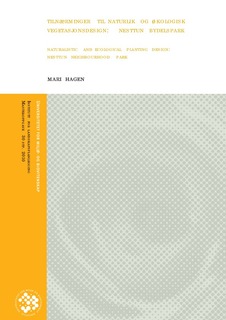| dc.description.abstract | Økologisk og naturlik vegetasjonsdesign er en trend vi ser tydelig i europeisk og amerikansk landskapsarkitektur. I Norge ser vi at tendensen
til å bruke disse tilnærmingene er voksende, men langt fra fremtredende. Samtidig erkjenner vi også
økt behov for bærekraftige løsninger; det kommer kontinuerlig nye bestemmelser fra internasjonale, nasjonale og regionale myndigheter som legger
føringer som krever et fremtidsrettet perspektiv. Denne oppgavens formål er å svare på hvorfor vi må tenke nytt i forhold til vegetasjonsdesign i norsk landskapsarkitektur, samtidig som den også redegjør for økologisk og naturlik plantedesign. Den gir også et praktisk eksempel på hvordan dette
kan utføres på et konseptuelt nivå.
Oppgaven består av en teoridel, forprosjekt med tilhørende områdeanalyse og en avsluttende
refleksjonsdel. Teoridelen, kapittel 3, gjør rede for det formelle grunnlaget for hvorfor man må tenke nytt, og
forsøke å tilnærme seg grøntanlegg på en mer bærekraftig måte. Denne delen sier også noe om manglende fokus økologiske tilnærminger til vegetasjonsforming i norsk landskapsarkitektur.
Hovedvekten i dette kapitlet ligger på en beskrivelse av fem tilnærminger til økologiorientert naturlik
vegetasjonsforming, med tilhørende konkrete prosjekteksempler.
En områdeanalyse av Nesttun sentrum (i Bergen kommune) og prosjektområdet gis i kapittel 4. Her kommer det blant annet frem at parkens arealer består av verdifull vegetasjon, og at det samtidig er behov for å forsterke kontinuiteten
i en fragmentert grønnstruktur. Dette danner grunnlag for prosjektstudiet i kapittel 5. Her blir kunnskapsbasisen fra kapitlene før brukt i et skisseprosjekt for Nesttun bydelspark. Fremstillingen av ideene for parken gir i hovedsak
et eksempel på hvordan man kan benytte de ulike vegetasjonskonseptene i en designprosess. Til slutt blir teori og prosjekt oppsummert i
sammenheng med en refleksjon over svarene på de ulike problemstillingene. Her kommer det frem at dersom norske landskapsarkitekter skal lykkes
med å skape bærekraftige grøntanlegg kreves det både holdningsendringer og formidling av litteratur, som på en tilgjengelig måte kan formidle
noe av den kunnskapen og inspirasjonen man trenger. I tillegg ser man at det også er vesentlig å jobbe på tvers av fag, og skape en god dialog
mellom de ulike aktørene i prosjektet. Ecological and naturalistic planting design is apparently a trend in European and American landscape architecture. In Norway, we can see that
the tendency to use these approaches is increasing, but still not typical. At the same time we also see
the need for sustainable solutions. Further on, conventions and regulations from international, national and regional authorities call upon an orientation towards, and an emphasize on, highly
sustainable projects. The aim of this thesis is to answer why we need
to find new solutions in terms of planting design in the field of Norwegian landscape design. The thesis will also give an account of ecological and
naturalistic planting design. It will also provide an example of how it can be performed on a conceptual level.
The thesis consists of a theoretical part, a site analysis associated to a preliminary project for Nesttun Neighbourhood Park, and a final part consisting of reflections upon the research problem
in relation to the results. The theoretical part, in chapter 3, explains the
fundamentals of why we must think in new directions, and try to approach planting design in a more sustainable way. This section also says something regarding the limited focus on
ecological approaches to planting design in Norwegian landscape architecture. The emphasis of the chapter is a description of five approaches to ecology-oriented naturalistic planting design, in
relation to examples of built projects examples. A site analysis concerning Nesttun (a district in Bergen) and the project area, are given in chapter 4.
The site survey reveals that the park site consists of highly valuable vegetation, and that there is a need for reinforcing the continuity of the fragmented
green structure. The qualities of existing vegetation and need for continuity forms the basis of the park design treated in chapter 5. Here, the knowledge
from the previous chapters is to form sketch for Nesttun Neighbourhood Park. The concept of the park provides an example of how one can use the
different planting concepts in a design process. Finally, the research problem, theory and project will be summarized and discussed in relation to each other. This part suggests that Norwegian
landscape architects needs both a change in attitude and more accessible literature to achieve the knowledge and inspiration you need to succeed in creating sustainable green spaces. In
addition, this part shows that it is essential to have
interdisciplinary interaction, and a close relation with those who perform the work, to achieve the desired results. | en_US |
